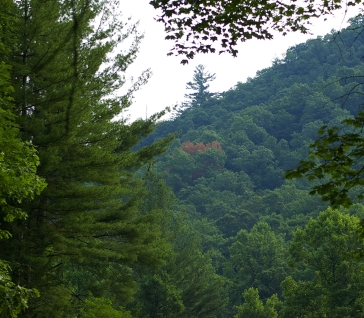To Our Readers,
July 20, 2012
Here at Enota Mountain Retreat, we enjoy an abundance of clean, fresh mountain air. This is never more noticeable than when our guests arrive from large, bustling cities such as Atlanta, where the air quality can sometimes be less than perfect. Unfortunately, escaping to pristine atmospheres can sometimes be a challenge. So today’s topic is all about lung health and how you can better prevent—or keep in check—lung-related illnesses. The first portion of this topic is related to Ozone Pollution.

OZONE POLLUTION
Ozone pollution—or outdoor pollution—is the most commonly talked about form of air pollution. Though the ozone layer helps protect us from the sun’s harmful rays (as well as some other bad radiation), it is not the healthiest thing to breathe in. So, first of all, what is ozone? Basically, ozone is O3, an oxygen molecule with 3 oxygen atoms. Normally, you’d think that the more oxygen the better, but this isn’t exactly the case. Ozone serves as a powerful oxidant and can cause damage to mucus and respiratory tissues.
Thankfully, the ozone layer is far above the Earth’s surface, but it can gather near the ground when greenhouse gases collect—though don’t think ozone comes directly from your car! Ozone forms from a reaction of sunlight on air containing hydrocarbons and nitrogen oxides. Because of this reaction, ozone is very much a daytime problem, rather than a nighttime hazard.
Cities and other urban areas that are plagued by heavy traffic are especially hard hit by high ozone levels. And when there are high temperatures and little to no wind, the problem only gets worse. So if you live in an urban area and are plagued by lung ailments such as asthma, it’s best to take proper precautions on especially hot or humid days. Pay attention, too, to the EPA’s Air Quality Index (AQI) to keep tabs on local outdoor pollution problems.
EFFECTS
So what exactly can ozone do to the body? Well, ozone can irritate the respiratory system and cause coughing, throat irritation, or even an uncomfortable sensation in the chest area. Ozone can reduce lung function, which makes it difficult to breath deeply. Of course, because of this, ozone is considered an irritant for those suffering asthma or other related problems. Another concerning side effect of ozone is the inflammation and damage of the cells lining the lungs. This can also lead to difficulties in fighting off lung or respiratory infections, or could even cause permanent damage to the lungs in children and adults through repeated exposure.
WHAT TO DO
When ozone levels are high, it’s best to simply stay indoors as much as possible and limit any necessary activities to the early morning hours or even after sunset. If this can’t be avoided, please try not to exercise vigorously outdoors. Try to keep away from high traffic areas—if at all possible and avoid using gasoline-powered tools or lawn equipment. Of course, it’s not always easy to follow such rules and stricture—especially if a job or responsibility includes any of these types of activity. The best thing to do is simply use caution on high level days and keep away from any unnecessary exposure.
That’s it for today, though more information and advice will be coming soon. In the meantime, try to think about any potentially harmful areas or activities. Remember, keep safe! And if you can’t run to the mountains to escape the pollution, keep inside and think of a cool summer breeze.
